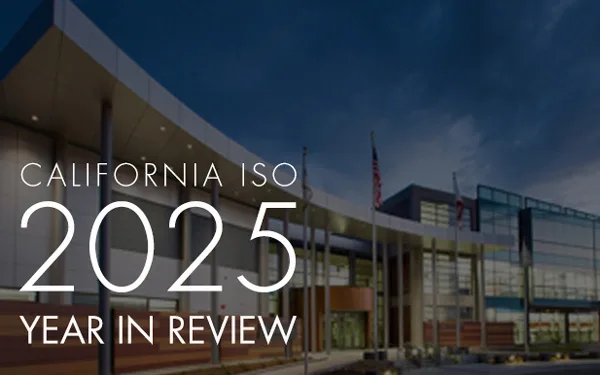Reliability and California’s clean energy future
Mark Rothleder, the ISO’s chief operating officer, participated virtually on August 9 in the state Senate’s Energy, Utilities and Communications Subcommittee on Clean Energy Future. After opening remarks about reliability challenges affecting the electrical grid, he answered questions from senators on the following topics. The answers have been edited for clarity and space.
The potential of Demand Response programs to reduce electricity demand during stressed grid conditions.
I don’t know exactly how much would be potential. I can say that in August of 2020 and again in 2021, when we really asked for the public to respond and reduce their demand, we did see approximately 2,000 to 3,000 megawatts of additional conservation and relief. Now, how that relief was coming about, whether there were potentially some backup generators or storage that were starting up, it’s not quite clear. But I know that the California Public Utilities Commission has adopted and tried to get some additional emergency load relief programs in place. I think that has been adding at least 800 megawatts to the existing demand-response capability.
But I will say the demand-response capability is probably one of the areas of untapped potential in the system. That demand-response capability needs to be something we can measure or accurately forecast how much it would be expected to reduce demand under different conditions when needed.
Looking forward, this is something that is a real opportunity. As you electrify the system, and you decarbonize and electrify – let’s say, the mobility sector, or heating, or cooling – there will be new opportunities for demand response benefits. That is a real opportunity, if you can manage that new demand and be able to control it and reduce it when you have these extreme types of events. That is a new opportunity as we transform other sectors and electrify the other sectors away from other fuels.
How much capacity is available, ready to be added to the grid over the next several years but for various impediments?
First, there’s well over probably three to five gigawatts of existing transmission capability that can support new interconnections now if you develop projects in the right locations. Identifying and contracting with those projects that are already in the request queue, are in the right locations, and have timely access to the supply chain to complete their project. So, there’s really not an interconnection issue from that standpoint.

In the longer term, yes additional transmission will need to be developed, and we will have to streamline the permitting and interconnection processes to keep up with the longer term development needs. There’s no a shortage of projects that are seeking interconnection. There’s over 240 gigawatts of resources that have applied for interconnection.
So, there’s plenty of resources wanting to interconnect to the system, more than what we would need for the transformation. The challenge is, making sure those resources that are wanting to get developed, can find interconnection in the right place, right location and are also getting contracted by load serving entities. As those projects move forward, additional transmission will need to develop.
Secondly, what is needed is contracting and power purchase agreements, because without power purchase agreements, these projects will not move forward. And they’re just clogging up the queue waiting for power purchase agreements. You have to clear that out to actually get these resources procured and developed.
And then thirdly, you need to solve the supply chain issues and align the supply chain issues. Overcome those to make sure those resources that can be developed, have the supply chain, are in the right location, are the ones getting contracted and are moving forward. And that is the challenge. How do you coordinate all those dynamic pieces to come together to get to an efficient development and interconnection outcome. It’s not just interconnection, it’s all three of those things.
The likelihood, as the ISO and state energy agencies have determined, of the grid being about 1,800 MW short of achieving the industry planning standard of no more than one outage every 10 years due to insufficient supply.
That 1,800 or 2,000 MW gap is the gap at this point that would be expected if all the procurement authorized was developed on time. Why is that? The factor that has changed since the procurement was authorized is there has been additional load growth forecasted in that time period. So, that gap, unless we do additional timely procurement at this point, is a high probability gap if once-through-cooling plants and Diablo retire by 2025.
I want to be clear, a gap based on the “1 in 10” scenario does not mean we will have certainty around load shed events. What it says is that the probability of load shed events is a higher probability than what industry practice would want to plan for. It doesn’t mean that those load shed events are inevitable. But that larger gap from the one-in-ten criteria indicates that you have a higher probability than you would want to under those conditions.
How to limit such risks.
Diversity of resource development is important. Regional, geographical and technological diversity are going to be important. And this is going to mean that we want to make sure that we have the ability to leverage the regional capability of the system. So even though I said that there may tightness of conditions across the region, other parts of the region are developing new resources as well. And the ability to bring in, let’s say, wind from other parts of the region when wind production is high, but wind production or solar production is low in California, becomes a real advantage if you can leverage that regional diversity in the system.

So, I appreciate the efforts to continue to look at regional opportunities, and we’ll just say that the Western Energy Imbalance Market has produced significant benefits. Over $2 billion worth of benefits for the region, including about 40 to 50 percent of that in California. Continuing the ability to both develop resources where you can and get them developed but also leverage the regional capability of the system is going to be key to the success.


